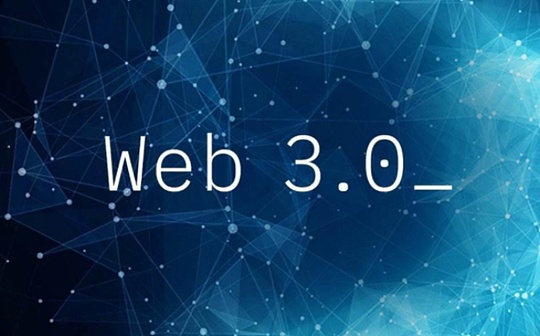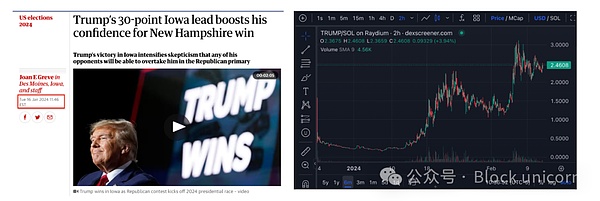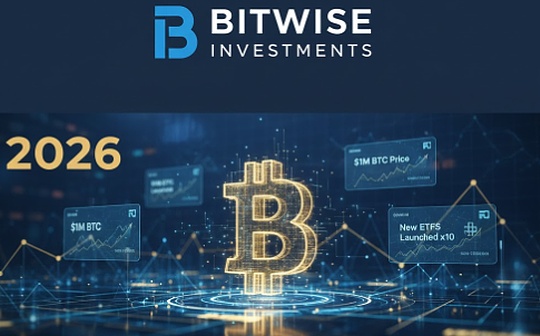
Author: SHAYON SENGUPTA, Multicoin Capital; Article Compilation: Block unicorn
“Price is news”It is a motto often used in the cryptocurrency circle. This sentence will be quoted whenever there is a rapid price fluctuation on the Internet, which attracts more participation and attention.However, I found that the negative expression of this sentence may be more profound:“News is price.”
In my contribution to Multicoin 2024’s Expectations, I describe a significant change in how asset pricing is, which I named as “Value Focus Theory.”In the crypto space, the main input to asset pricing is not a multi-factor model around risk premiums or cash flows, but rather a perceived amount of time, effort, and money invested by the community around an asset.It should be noted that this is not a normative statement, but rather that we have observed the flow of funds in history as an asset class.
The Internet realizes arbitrary and two-way information transmission.Cryptocurrencies are built on these basis, through the realization of arbitrary, two-way transfer of value.Today’s consumer internet—streaming platforms, online media, mobile apps, social media, etc.—can be summed up as an attention market, and therefore money and attention increasingly have similar characteristics.
In the 1930s, Benjamin Graham needed to wait for quarterly reports and financial statements to express his theory of value investment through human brokers purchasing paper stock certificates.In 2020, there was news about hedge funds shorting Gamestop. Retail investors spread this news across all corners of the Reddit community, attracting thousands of retail investors to buy Gamestop stocks on Robinhood, causing the stock price to soar within 30 days15 times – confronting hedge funds and exploding the positions of hedge funds (retail investors fight Wall Street).Consumer Internet and encryption infrastructure make the basic units of information and value smaller (Block unicorn notes: When the information gap continues to narrow, the price difference in the market will also be smoothed), and at the same time increases data consumption and value transactions.quantity and frequency.As this trend develops, the theory of value attention becomes closer – information is money, and money is information.
While markets of attention and value exist in reality, we have not really seen their collision yet.When we think about crypto consumer applications, this is what we are looking for.Encryption enables the creation of new assets around attention quickly and transactions where such attention is gathered: consumer-facing applications.
In the coming years, we expect consumer developers to meaningfully incorporate cryptocurrencies into the structure and user experience of their applications, changing the scope of content and trading venues at scale.Internally, we refer to such applications as “Publisher Exchanges.”
Block unicorn comment: “Publisher Exchange” means that content and transactions can be published on the Web3 social platform.Allow users to post content, attract attention, realize transactions, and gain benefits from it.
Publisher Exchange
Exchanges naturally have product market fit in the cryptocurrency because one of the core uses of cryptocurrencies is to transmit value.Coinbase (fiat currency exchange and centralized exchange), Tensor (digital collectibles exchange), Jito (trading intention and block space exchange) and Phantom (order flow exchange) are all exchanges in different forms.
In the crypto space, exchanges are similar to the main publishers in the consumer Internet (such as X, Instagram and The New York Times): Publishers control the flow of attention on the Internet, while exchanges control the crypto spacecapital flows in.
As we think about the next generation of consumer applications, we expect to remove the boundaries between exchanges and publishers to create a new experience that combines currency and attention.
Kyle (Multicoin CEO) wrote about UI layer composability in his 2024 idea contribution.The simplified meaning of this argument is that the next large online exchange will not have traditional order books, depth maps, etc. like Coinbase; instead, it will be more like a short video app where users can bet on upcoming creations.The communication power of the content, or a group chat, friends can instantly launch NFT collections based on internal jokes or memes, or a curatorial platform in the style of are.na, and designers can taste itand gain reputation and wealth.In other words, through the unique functionality of encryption, consumer apps are both publishers and exchanges: publishers exchanges.
Publisher Exchange adds the surface area of new asset issuance by embedding issuance and native transactions into the application front-end and allows these assets to be interacted and coordinated in a novel way.Introducing transactions in familiar places may seem narrow or simulated, but we believe that narrow markets are the beginning of discovering emerging behaviors that will lead to the birth of huge new platforms.
This will be a golden age of experimentation—a blank state for developers to conduct experiments that combine native issuance and transactions with new application experiences.”Crypto-native consumer applications” will treat these design principles as first-class citizens.
Emerging Publisher Exchange Categories
Publisher-Exchange (Publisher Exchange) aims to trade at any given moment at the same time as the user is concerned about to meet the user’s needs.Next-generation consumer applications in the crypto space will allow users to issue and trade assets locally, thus directly monetizing the user attention they capture.
For the founders who want to build Publisher-Exchanges, we believe some of the design principles from publisher and exchange history will be relevant.
In the history of the consumer internet, publishers are essentially content markets, and the market is driven by two core attributes: 1) discovery and curation (presenting content users want to see and interact with), and 2) trust and reputation (towards)Guarantee provided by the user).Successful publishers can generate strong “liquidity” by measuring the attention time users spend on them.That’s why Upworthy measures success by “focusing minutes” and why Elon Musk is fascinated by “not allowing users to regret what they see every minute” and “not allowing users to regret what they see every second”.——Simply put, it means that the content users see every minute and every second is valuable and will not disgust users.
For publisher-exchanges, the key is to first build an engaging core experience that attracts users’ time and commitment, and then embed asset issuance and transfers to align them with the unique way of engagement they generate.
Instead of simply treating an exchange as a place of trading, we regard it as an Athenian market where people interact and exchange experiences, values and information in a strictly defined, context-specific environment.With this in mind, we conceived several broad categories of application that we consider as a good opportunity for the emergence of Publisher-Exchanges.
Communication Tools
Messenger (communication application) is the main candidate for publisher exchanges.
An early example of this argument can be seen in WhatsApp and WeChat.Both platforms have a rich developer ecosystem in India and China and are built on a strong, state-mandated digital payment infrastructure.This allows teams like Sama and Meesho to embed AI annotations and local merchant e-commerce’s labor market directly into the context state of users’ social graphs on these platforms.
In the field of encryption, Telegram is a de facto communication application, and their robot APIs create a vast design space that can be embedded in the distribution and value exchange experience.Products like Dialect Operator and Maestro are examples of this view.They indicate that users want to be able to trade directly in their chat.These Telegram trading bots meet the definition of publisher exchanges because they bundle discovery and intent with execution, narrowing the cycle between attention and value transfer.Telegram has its own hidden app store (go to search and enter “tapps”), with hundreds of bots that allow users to send payments, play games, discover content, and more.

While these publisher exchange bots are used to shorten the execution time for retail traders to look for super high returns in closed chat groups, there are further opportunities to significantly increase the scope of assets that can be issued and traded.We expect chat groups to be the foundational layer for new forms of work (to be paid for tasks directly in chat), special projects (to crowdfund new initiatives in large conversations) and entertainment (to issue memecoin like sending gifs), all of which arePublisher exchange experience.
Content NetworkThe largest social media applications (Instagram, TikTok, X, Youtube) are content markets where creators of music creators, posts, videos or other user-generated content compete for users’ attention.Creators can then use the attention they have accumulated to sell content or branded products.
The North Star of the encrypted content network is the audience supporting individual creators or content clips that creators gain a significant share of the content they create.This is the initial theory of creator tokens, but we found that if these creator tokens are disconnected from the platform where their audiences are located, they may be unlikely to succeed alone.
We are seeing early experiments with new content networks today, each of which issues and trades new types of assets in applications.We envision a new type of content market where users come for entertainment but stay because of the market.
Unlonely is a streaming platform that embeds token issuance and prediction games directly into streaming and chatting.Farcaster Frames are another example, they can be directly in on-chain state and interact in food, providing unlimited opportunities for issuing and trading assets in familiar places.

Today, most content networks monetize users’ attention through display ads.Ad-based customer acquisition models often have the problem of poor funnel conversion and are explicitly a suboptimal solution because it often interrupts the user experience; users realize they are being marketed.
Display advertising is a legacy of the cryptocurrency era.A more basic method for merchants to acquire users is to pay users through direct value issuance (DVI) – that is, to directly use tokens to pay users.
Advertisers should be able to distribute value directly to users, rather than providing targeted advertising based on user behavior/group building.A content network does not need to place an ad about a sports betting platform between posts in the NBA game live room where users are scrolling — instead, it can allow a sports betting platform to airdrop a $50 credit directly to users.
Instead of trading through the platform as a rental intermediary, advertisers directly hand over their customer acquisition cost budget to the end user.In turn, the content market can provide their users with better products: they go from a place where they are actively tapped to see their attention and do not see the resulting benefits (through display ads) to earning according to their attention patterns.and spend assets and directly contact the financialization process (via DVI).
The backdoors embedded in the ad network can be even more compelling—by providing each user with an address, it enables applications to embed universal financial services at no cost that can be added to the deep interactions that users already have.
Information Market
Search engines in the 90s focused on organizing information on the internet, initially focusing on static web pages, and then expanding to new forms of media and content.Initially, the cost of accessing this information was subsidized through advertising.
Today, information on the Internet is much more than web pages—it is distributed in thousands of forum posts, group chats, podcasts and private databases.Information markets (e.g., prediction markets, alternative data providers) are a way for users to directly filter out signals rather than noise from all these sources and extract the probability of results from a large amount of qualitative information.
Although the most successful information markets do not currently rely on encrypted railroads, we believe they can be reinforced by encrypted primitives.The design space either financializes the information itself based on quality or directly embeds these markets into places where first-party information sharing is shared.
Forecast markets like Polymarket are actually binary calls around future results such as elections or sports events.Historically, they have failed to accumulate sufficient liquidity or attention to serve as a reliable source of information.In contrast, cultural assets (such as meme coins or NFTs) have proven to have higher attention (and information) than closed forecast markets because they do not have a fixed expiration date and can have their own life cycle..For example, the volume of NFTs and tokens related to Trump has been higher than that of the Polymarket forecast market.

Therefore, new spot assets that directly track attention may represent agents who are more interested in attention or information flow.Embedding these types of assets into a news release platform or editorial publisher may be more attractive than the binary, fixed-expired constructs of the past.Just as Numerai draws from the principles of token planning registration, running machine learning competitions on obfuscated financial data, we believe that a general information market for new categories of information can be built on the same principle.
Imagine a StackExchange-like forum where voting and reputation primitives have financial value, or a Pinterest-like curatorial board where users can bet on emerging trends and behaviors.There is a large amount of high-quality information on the Internet today, mostly contributed by users without any financial motivation – what is missing is the form of appropriate aggregation and monetization, which is where crypto primitives are most useful.
We are excited about the new manifestations of this argument, and in general, we are excited about the tokenization of the intangible amounts in the content network: accuracy, reputation, humor.
Professional Interest Community
Tokens allow the community to focus on novel issues and direct resources toward these issues.ConstitutionDAO proves that a memecoin can gather enough funds to bid for a rare cultural relic, and after the auction is over, the network itself becomes active.
The point in this case is that when tokens have a mission attached, they are more likely to coordinate real-world actions.This collaborative funding model can support new businesses that traditional financing and research lines often overlook: for example capital-intensive projects such as VR headsets, corners of open source software, art spaces, or drug discovery for rare diseases.
Tokens uniquely promote capital formation from distributed sources and give capital providers strong ownership of the capital product.This means that groups around the world can coordinate capital to conduct experiments on a large scale, commoditize the results of these experiments, and return the proceeds to token holders.
HairDAO and VitaDAO are examples of this situation.We have seen new platforms for collaborative research that are funded and maintained by the attention accumulated around various neglected issues.
Unlimited trading canvas
Consumer encryption applications will be a generative shift, not imitative.The close connection between crypto native attention, capital formation and coordination we describe in this article, as the main unlocking of crypto is that transactions can happen anywhere.Rather than just shifting existing economies to the chain, encryption unlocks the new economy of attention so that like-minded people can trade minutes for dollars and vice versa.








